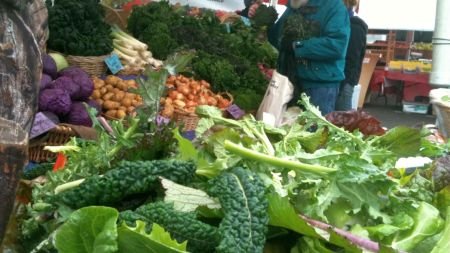September is Organic Harvest Month in Oregon, U.S.
What may have been considered years ago as fringe sector of agriculture with a narrowly focused market base has blossomed into an increasingly popular offering that has become mainstream to many consumers.

(SALEM, Ore. ) — Organic production remains a vibrant and expanding sector of agriculture 365 days a year, but September will include a special recognition both in Oregon and in the US.
While the nation celebrates the ninth annual Organic Harvest Month, a yearly salute to organic agriculture in Oregon has been going for decades with the 26th annual Organically Grown in Oregon Week to be held September 14-20.
What may have been considered years ago as fringe sector of agriculture with a narrowly focused market base has blossomed into an increasingly popular offering that has become mainstream to many consumers. Statistics from the most recent US Census of Agriculture proves the point.
“Organic agriculture is right at home in Oregon,” says Oregon Department of Agriculture Director Katy Coba. “The same great growing conditions and wonderful diversity of products that serves all of Oregon agriculture benefit our organic producers as well.”
According to the 2012 Census of Agriculture, Oregon had 554 farms reporting they had marketed organic products with sales exceeding $194 million. That’s only 1.5 percent of the state’s 35,439 farms and still less than 4 percent of Oregon’s total cash receipts for 2012, but the organic sector has made serious inroads over the past several years.
For many years, consumers were not able to find organic products readily available in mainstream markets. They would have to go to a health food store or a specialized niche market.
Today, shoppers can find organic products in nearly every mainstream grocery store either integrated with other foods or placed in a special section for organics.
“Organic agriculture gives Oregon consumers a choice in the bounty of products they enjoy,” says ODA Marketing Director Gary Roth. “What I personally celebrate during this special month is the availability of organic products that just wasn’t there 20 years ago. We grow so many different crops in Oregon, and we have so many different organic crops to offer as well.”
The Census of Agriculture provides more perspective on organic production. From the 2007 census to the 2012 census, the number of organic farms in Oregon dropped from 799 to 554. Still, Oregon is tied for sixth of all states in the number of organic farms.
“The drop largely took place in the smaller operations, those farms with less than $5,000 in annual sales,” says Dave Losh, state statistician with the Oregon field office of USDA’s National Agricultural Statistics Service (NASS)..
However, the market value of organic products in Oregon increased dramatically over the five year period from $88 million to $194 million. Oregon ranks third of all states in total organic product sales behind only neighboring California and Washington.
At the county level in Oregon, all but three counties reported sales of organic products as part of the 2012 Census of Agriculture. Lane County leads the way with 60 organic growers followed by Clackamas (53), Jackson (36), Linn (36), Yamhill (36), and Marion (35) counties.
Even underpopulated Wheeler County in Eastern Oregon reports having one organic grower. In terms of sales of organic products, Klamath County surprisingly leads the state with more than $19.7 million in sales followed by Linn ($18.7 million), Clackamas ($18.5 million), Yamhill ($15.3 million), and Umatilla ($11.4 million) counties.
Statistics from another source– a survey by the Organic Trade Association– show that total organic food sales jumped 10.2 percent nationally from 2011 to 2012. Specifically, US sales of organic fresh produce increased by more 13 percent to $9.7 billion. That same survey says organics account for 4.3 percent of total food sales, but the market share is bigger for organic fruits and vegetables, which accounts for one of every ten dollars spent by US consumers on fruits and vegetables.
On the global scene, sales of organic foods have grown 25 percent between 2008 and 2011, according to a British sustainable agriculture advocacy group. Europe and the US account for 90 percent of global sales but some of the sharpest increases are taking place in Asia, especially the more affluent countries of Japan, South Korea, Taiwan, and Hong Kong.
For Oregon, which relies heavily on the export market, the organic trend is something to watch.
Oregon has unique status in the organic world based on its history of early adoption of certification standards. Oregon passed the nation’s first organic legislation in 1973 and revised the Oregon Organic Foods Law in 1989, which served as the model for the current national organic standards. It was also the first to establish a statewide advocacy group – the Oregon Organic Coalition.
In 2010, Oregon Tilth, which provides a majority of the state’s organic certification, was joined by ODA in bringing together several agencies and organizations that pledged their support by signing an organic agriculture letter of intent. The document continues to encourage additional research and outreach, promote sharing of best practices, and generally gives support for organic agriculture on a national level.
In response to industry demand in 2009, ODA became an accredited certifying agent for the National Organic Program (NOP). Like Oregon Tilth and others, ODA inspectors audit organic production and handling operations to certify they meet USDA standards. Currently, ODA has 89 certification clients.
“We’ve seen strong growth in specialty food processors using local organic ingredients in their products,” says Lindsay Eng, ODA’s Director for Market Access and Certification programs. “There has been an increase in small, entrepreneurial businesses that produce and market such items as snack foods, chocolate, and niche products like kombucha – all relying on certified organic ingredients.”
The growth in certification is a reflection of the times, and September is the time to celebrate the production and harvest of organic agriculture in Oregon.
Source: Oregon Department of Agriculture



